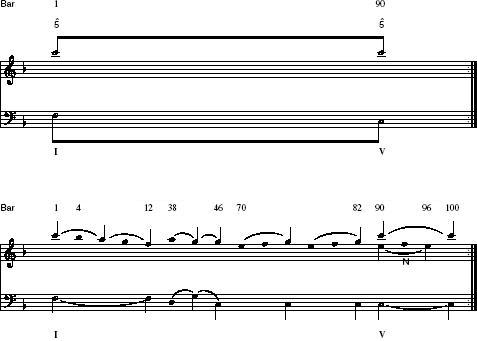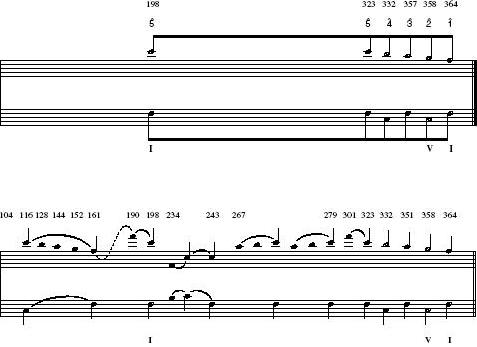3 Analysing the form of the first movement
3.1 Points to understand
You are now ready to follow an analysis of a much longer and more complex piece of music. We don't have space in a single course to look in any detail at the actual procedure of analysing the harmony of the whole of the rest of the Eighth Symphony, so I will discuss the analysis of only one other movement, the first movement. Here I will present you with my own completed analysis, rather than lead you through the steps that went towards creating it.
Activity 10
Listen again to the first movement of the Eighth Symphony. Follow it in thescore. Then make notes on the following questions.
Click to open the full score of Beethoven's Eighth Symphony, third movement [Tip: hold Ctrl and click a link to open it in a new tab. (Hide tip)] .
-
Which points seem harmonically most puzzling in terms of their place in the form? Try to identify three or four specific points that need to be explained by any analysis of the movement.
-
Which note of the tonic chord is most prominent early in the movement (in other words, which note would you choose as the primary tone)?
-
Where is the decisive closure of the tonic key (in other words, where would you place the structural cadence of the movement)?
Answer
Discussion
-
You have already done a lot of work with this piece of music, and your list of points will reflect what you view as particularly important. My list of particular moments which an analysis of the form of the movement has to take into account is as follows.
-
The entry of the second subject, which appears to be in the ‘wrong’ key, D major (bar 37).
-
The beginning of the recapitulation. The start of this section can be placed at bar 190 or at bar 198. The former has impressive texture and dynamics, but the latter has more conclusive harmony.
-
The transposition of the second subject in the recapitulation, where it is presented first in B♭(bar 234) and then in F major (bar 242).
-
The place of the coda (bars 301 onwards) in the form of the movement. This more than anything else will affect your answer as to where the main structural cadence is located. The recapitulation ends with an emphatic cadence in the tonic and repeated octave Fs (bars 293–301), but the coda still follows a fair amount of chromatic modulation before the final cadence.
-
-
It is difficult to avoid choosing C, the fifth of the scale, as the most prominent note of the tonic triad in the melody, and therefore the primary tone. Two moments which encourage this are the opening of the melodic line in the very first bar, and the thunderously repeated Cs at the end of the exposition (bars 100–104).
-
There are several places towards the end of the movement where Beethoven re-establishes F major with great insistence. Perhaps you chose the end of the recapitulation, where, after dominant and tonic chords are repeated several times to establish the cadence, the tonic chord thunders out fortissimo in arpeggios through almost three octaves in the violins (bars 293–7). This would make the structural coda of the voice leading coincide with the coda section of the sonata form. Or again, perhaps you chose the moment where the tonic reasserts itself (again fortissimo) for the last full statement of the first subject in the coda (bars 323ff.). Or perhaps you chose the final cadence in bars 358–64, where the tonic chord arrives with self-effacing quietness to close the movement. All three passages have competing claims to be the point of true closure of the form, and clearly this is something that requires a deeper analysis.
This is anything but an exhaustive list even of the interesting features to do with form in this movement. I have left out lots of wonderful aspects of Beethoven's harmony which do still feature in my analytical graph; the above list is more a selection of some moments that simply cannot be avoided whatever the method of analysis. Now it is time, though, to consider my thoughts about the movement in the light of all the work you have already done with it.
Activity 11
First, look at my analytical graph of the movement (Example 10). I have arranged it on two levels for greater clarity, so that Example 10a presents only the fundamental structure of the movement, whereas Example 10b, aligned underneath it,gives a little more detail, still at the background level.
Compare Example 10 with the score (at link below), using the bar numbers to identify the events in the music represented by each point of my background reduction.
Click to open the full score of Beethoven's Eighth Symphony, third movement.
Then, try listening through to the movement again, but this time follow the music with the graph rather than the score.
What does the graph claim about the way Beethoven has structured the movement? Refer especially to the moments listed in the discussion of the previous activity. Do you find this analysis convincing?


Answer
Discussion
First, I'll summarise what the graph indicates about the four passages identified in the first question of Activity 10.
-
The harmonic importance of the second subject in the exposition is analysed as its eventual establishment of the dominant, C major, at bar 46. The apparently ‘wrong’ key of D major (bar 37) is seen as part of the approach to C major, since at a background level it moves to a G major harmony which is the dominant of the dominant (this happens in bars 44–5).
-
I have analysed the harmonic importance at the beginning of the recapitulation as being located in bar 198. This is shown in both Example 10a and Example 10b, because this is a crucial moment in the voice leading of the movement, where the prolonged tonic harmony supporting the
 of the fundamental line is re-established.
of the fundamental line is re-established.
-
The transposition of the second subject in the recapitulation (bars 234–43) is analysed in Example 10bsimilarly to the appearance of this theme in the exposition, so that the key of B♭is seen as part of the progression to the tonic, F major. The way that Beethoven handles the transposition here emphasises the C in the top voice, which is part of the prolongation of the fundamental structure.
-
The coda's principal function in the movement in terms of voice leading is analysed in both Example 10a and 10b as being the descent of the fundamental line. This means that the beginning of the coda proper (bar 301) is analysed, at this very deep level, as merely a subsidiary stage of the prolongation of the primary tone, C, in the top voice. This is a good example of a place where an event that is very striking at first hearing (the top F in bars 297–301) is of lesser importance to the structure of the whole movement, in my view, than one might at first think. Even after the recapitulation closes, the C is still to be resolved (glance at bar 323 in the score to see its prominence), and this happens over quite a long section from bar 332 to bar 364. The coda is therefore seen as the decisive closure of the form of the movement.
Let's look at this analysis in a little more detail. The structure of the development sectionis summarised here as another descent from C down to F, and a lengthy register transfer of this F up an octave between bar 161 and bar 190. The way that a descent from C to F repeatedly forms the unifying structure of a whole section at a very deep level makes it what we might call a ‘structural motive’ in the work.
Another issue which should be considered is where the recapitulation begins.
Using the voice-leading graph it is possible to see that the thematic recapitulation and the harmonic recapitulation happen out of synchronisation with each other. This is similar to the way that when the second subject enters, both in the exposition and the recapitulation, it is before the harmony has reached its destination key. In other words, this deliberate lack of synchronisation between theme and tonality is a structural feature shared by the return of the first subject and the entry of the second subject – what we could call another sort of structural motive. Indeed, this ‘correction’ of the key of the second subject is very typical of Beethoven – as opposed to Schubert, who often avoids the dominant key for the whole of the second subject area in an exposition.
Before we consider the fundamental structure analysed in Example 10, notice that I have been deliberately inconsistent regarding the amount and level of middleground detail I have included in Example 10b. At some points I have included quite local features (such as the harmonic movement in bars 37–46 and 234–43); at others I have taken a much broader sweep of music (as with the descent in bars 116–60); other sections I have more or less omitted altogether (such as the marvellous harmonic detail in bars 160–90). This is always the case with a graph of the background structure of a long and complex piece of music. I have included details which I think are particularly relevant to my personal interpretation of Beethoven's formal thinking, and another analyst might have chosen other details to emphasise. Whilst this analysis is personal, it is not arbitrary. The analysis always aims to interpret and explain the notes in Beethoven's score. Now let's see what other insights into the form can be obtained from this attempt to analyse a fundamental structure.
